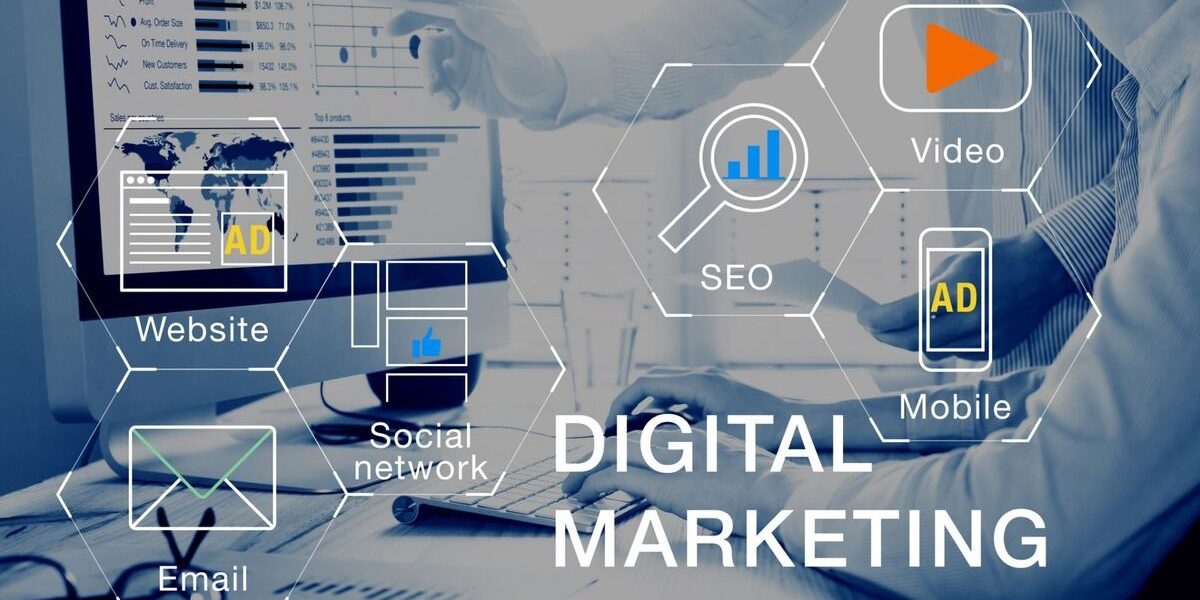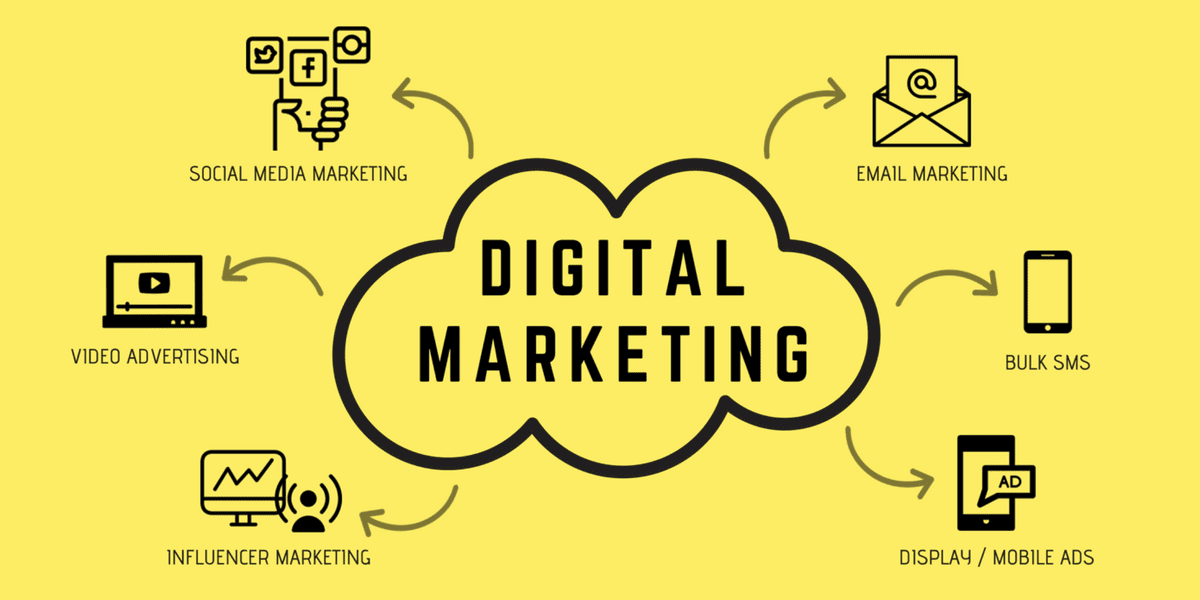Introduction:
If you were to guess the number of people on the internet, you might think of “millions of people” using it daily. However, that number is far larger than most can imagine. In 2022, about 5.3 billion people were using the internet, and this number continues to grow. This ever-expanding audience presents businesses with the opportunity to reach new customers every day. This is where digital marketing comes into play. To gain a firm understanding of digital marketing, let’s explore the who, what, why, and how.
The Why

Before diving into what digital marketing entails, let’s explore why it’s important. When we discuss the what, you’ll realize something crucial: you’re already engaging in digital marketing, often without even realizing it. Digital marketing allows you to reach a larger audience more effectively and efficiently than traditional methods, leveraging digital resources you likely already have, such as your website or social media pages. By utilizing these resources, you can:
- Focus your efforts on the demographics most likely to purchase your product
- Level the playing field with larger brands in your industry
- Quickly and easily measure your marketing effectiveness
- Adapt swiftly to changes
- Engage directly with consumers at every stage of the marketing process
- Improve the conversion rate of your overall marketing strategy
That last point is particularly important because digital marketing doesn’t have to stand alone.
For example, imagine you’re attending a convention in your industry and handing out postcard flyers. With traditional flyers, the most concrete metric you can measure is conversion—when someone responds to the call-to-action and makes a purchase. However, if you include a scannable QR code on the flyer, you can directly measure interest by tracking when visitors come to your website from the QR code and what links they visit afterward.
A QR code can seamlessly link your traditional and digital marketing efforts. Instead of directing people just to your website, you might bring them to a landing page that invites them to join your mailing list. Alternatively, a QR code could direct them to your social media page or Linktree, encouraging them to follow you.
The What

Now that we understand why digital marketing is so important, let’s explore what it entails. Digital marketing is exactly what it sounds like: a method for reaching your target market through digital means. Although it’s often called “online marketing,” that term can be limiting because we don’t always associate our digital activities with the internet.
For example, do you play mobile games on your phone? Since you’re engaging with the games through an app rather than a website, you might not consider this “online engagement.” However, the ads you see in many mobile apps are a key part of a company’s digital marketing strategy. By thinking in terms of “digital” rather than “online,” you can better recognize the myriad possibilities for using digital marketing to reach your audience.
With that in mind, typical digital marketing channels include:
- A company’s website
- Search engine optimization (SEO)
- Social media pages and channels (including YouTube videos)
- Email marketing
- Ad marketing (through pay-per-click ads on websites, search engines, social media platforms, and mobile apps)
- Affiliate marketing (partnering with influencers and industry experts to promote your brand)
By leveraging these channels, you can craft a comprehensive digital marketing strategy that effectively engages your target audience across various platforms.
The Who

In digital marketing, the Who is crucial. It includes you, your marketing team, your target audience, the marketers you collaborate with, the affiliates you partner with, and the platforms you use for marketing. Essentially, in digital marketing, the Who also encompasses the Where. Let’s break down the most fundamental aspects of the Who.
Your Audience
Because so much data is captured about consumers and businesses, digital marketing allows you to target an audience as broad or as narrow as you need with ease. If you offer a product with broad appeal, you can easily target a wide audience. Conversely, if you also offer a service that fits a niche interest, you can target that service to a small audience without having to pivot your overall strategy. This flexibility in audience targeting is one of the key strengths of digital marketing, enabling you to reach the right people with the right message at the right time.
The Platforms
Digital marketing affords you multiple ways to reach your target audience (and work with affiliates) by engaging on multiple platforms. Your platforms include,
The How

Now that we’ve covered the Why, What, and Who of digital marketing, let’s explore How to implement digital marketing effectively.
-
Define Your Goals: As with any type of marketing, start by defining what you want to achieve. Are you looking to increase brand awareness, generate leads, drive sales, or engage with your audience? Clear goals will guide your strategy and help measure success.
-
Identify Your Target Audience: Determine who is most likely to buy your product or service. Who do you want to attract and convince to buy? Understanding your target audience is crucial, as it shapes not only your marketing message but also where you focus your efforts.
-
Establish a Budget and Allocate by Channel: Decide how much you want to spend on your overall marketing efforts, then allocate your budget across different digital channels. Some channels might require more investment than others. For example, YouTube may need funds for video production and promotion, while influencer marketing might involve providing products or services for review.
-
Balance Paid and Free Digital Strategies: Digital marketing is not just about paid promotions. Your SEO efforts, social media posts, and other organic content like blog posts are equally important. The balance between paid and free strategies should align with your overall goals.
-
Create Engaging Content: Whether it’s an ad, social media post, video, blog, or email, content needs to be engaging to be effective. Take Ryan Reynolds’ YouTube channel as an example. Although much of the content is essentially ads for Mint Mobile or Aviation Gin, they are engaging and entertaining, using humor and personality to capture the audience’s attention.
-
Optimize for Mobile: As mobile use continues to grow, it’s essential that all your digital marketing assets are mobile-friendly. Ensure your website, social media posts, and other digital content are easily viewable and engaging on mobile devices.
-
Conduct Keyword Research: Understand the keywords your audience uses to search for information related to your industry. Focus on keywords that will drive your target audience to your content. These keywords aren’t always product-specific, so thorough research is key.
-
Iterate Based on Analytics: Measure your marketing efforts through analytics. Identify what works and what doesn’t, and make changes based on these insights. When something is successful, continue to build on that strategy.
We’ve only scratched the surface of what digital marketing is and how it works. Interested in learning more about what digital marketing can do for your business? Get in touch to discuss tailored digital marketing options for your needs.
